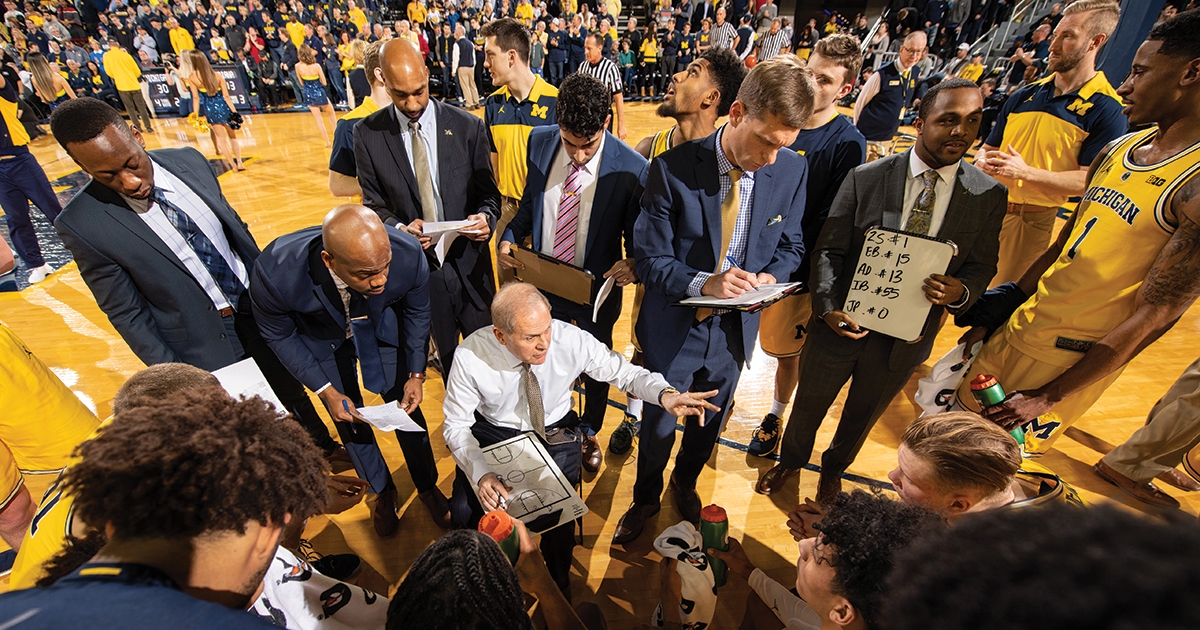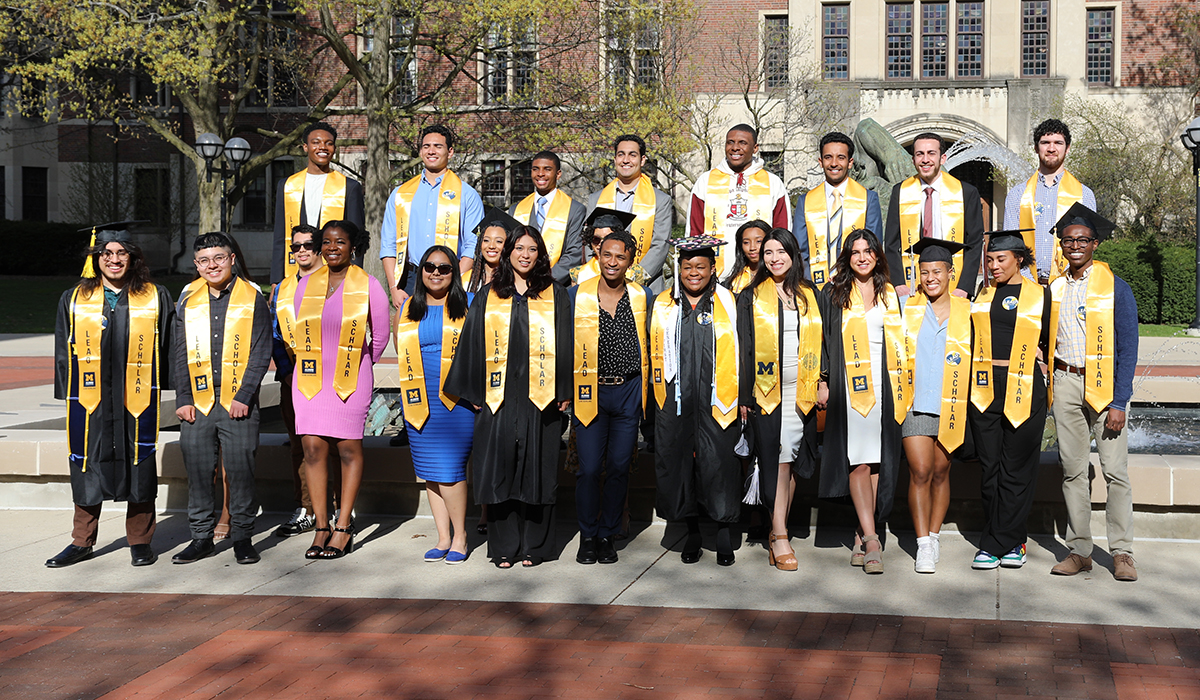John Beilein, the U-M men’s basketball program is back on top, thanks to a dozen years of smart recruiting and strong leadership.
A YEAR AGO, JON TESKE was a struggling backup center. He was mocked on social media for seeming uncoordinated and hesitant and drew groans from the fans when he stepped onto the basketball court to relieve the flashy, tongue-wagging, fan-favorite Moritz Wagner.
John Beilein, of course, didn’t care. The 7-foot-1-inch kid from the Cleveland suburbs had what the coach saw as raw talent and, more important to Beilein, a will to learn. And so through the spring and summer, Teske remained in Ann Arbor under the intensive oversight of the team’s strength coach. He bulked up and practiced his shooting and jumping, but equally important, he gained the confidence that comes with physical and emotional maturity.
Nobody—except maybe his opponent—groans anymore when U-M junior Teske is on the court. The once-awkward player, who took only two three-point shots (both misses) in his first two years as a Wolverine, this season had hit 21 of them by March. His rebound average has doubled, his points-per-game average has tripled, and his blocked-shot average has nearly quadrupled.
“Jon’s rebounds and Jon’s finishes right now are just so much easier than some of the drama we’ve had before,” Beilein said after Teske’s career-best 22 points led the team to crush Nebraska in the season home finale on Feb. 28. “He’s just understanding which way to turn.”
Teske’s transformation is not extraordinary given the talents of Beilein, whose arrival at U-M in 2007 marked the beginning of a sustained, high-level basketball era, arguably unmatched in the team’s history. The Wolverines advanced to the NCAA National Championship game in 2013 and 2018, and the 2018-19 team has all but assured Beilein’s ninth appearance in 12 years in the March Madness tournament.
“I just wanted our basketball team to reflect this great University that’s so highly ranked around the world,” Beilein said just after the team’s home win over Maryland on Feb. 16. “Why can’t the basketball team be just as good as the football team or the hockey team?” Beilein often asked himself. “I wasn’t trying to flip us to be a basketball school. I was just trying to keep up with this University.”
TESKE IS ONLY THE MOST recent example of Beilein’s long history of recruiting under-the-radar players and buffing them into marquee stars, from Stu Douglass, ’12, and Zack Novak, ’12, to Nik Stauskas, x’17, Spike Albrecht, ’16, and Muhammad-Ali Abdur-Rahkman, ’18. And despite a late-season falter against Penn State and powerhouse Michigan State, the consensus in the sport is that the current starting lineup of Teske, junior Zavier Simpson, sophomore Jordan Poole, senior Charles Matthews, and freshman Iggy Brazdeikis has the tools to go all the way.
It’s just a real program now,” says Michael Rosenberg, an Ann Arbor-based staff writer for Sports Illustrated. “It’s not thrown together; they didn’t luck into anything. The pieces all fit now. They’ve got the combination of experience, character, coaching, toughness, and talent.”
Indeed, it was a January 2007 Sports Illustrated article by another basketball scribe, Grant Wahl, that played a role in U-M’s athletic director at the time, Bill Martin, MBA’65, deciding to recruit Beilein, who was the head coach at the University of West Virginia. Long enamored of the scrappy coach who had already turned three flailing programs—West Virginia, Richmond, and Canisius—into March Madness competitors, the athletic director took special note when Wahl wrote that Sports Illustrated had “asked two dozen coaches to name the top innovator in the game today, and the most popular choice was Beilein.”
Beilein was easily sold on U-M. “We had that one meeting and shook on it,” Martin recalls. “I can’t even remember how long it took to sign a contract, but that was a piece of cake.”
What remains “innovative” about Beilein, to this day, is his recruiting style. Rarely does he chase after the most highly touted high school prospects. Instead, he is just as likely to watch a YouTube video of a kid in Germany and decide to turn him into an NBA-caliber star, as he did with center Wagner.
This year, it’s the surprise success of Teske and Brazdeikis that have awed people. “I think we go for ‘top prospects,’ but we probably rate them differently than other people would rate them,” Beilein says. “It’s a very slippery slope of recruiting guys who you may lose really early to the NBA. You’re renting them for a few years, and you’re just a wait point, not a destination. We’ve been trying to find guys, whether they’re rated highly or not, who see Michigan as a destination.”
The current squad is well aware of that approach and grateful for it. “I don’t think many people expected for my season to go like this and our season to go like this,” Brazdeikis said after the Maryland win on Feb. 16. “Coach Beilein and the coaching staff—they’re the best in the business, and they know what they’re doing at all times.”
TO UNDERSTAND HOW FAR the basketball program has come, it’s important to recall how far it had fallen from its pinnacle year of 1989, when the Wolverines won the NCAA National Championship in an 80-79 game against Seton Hall. The win translated in the fall of 1991 into one of the sport’s most heralded freshman recruiting classes, the Fab Five, who returned U-M to the NCAA Championship game in 1992 and 1993 and notably popularized the wearing of baggy shorts.
Everything turned to ash with the Ed Martin (no relation to Bill Martin) scandal in 1996. Martin, a longtime Wolverine booster, would go on to plead guilty to running a gambling operation through which he laundered money and loaned some $616,000 of it to four Michigan players, including Fab Fiver and future NBA player Chris Webber. Eventually, the NCAA accepted U-M’s self-imposed punishment, which included vacating the team’s 1992 Final Four appearance as well as the records for the 1993 and 1996-99 seasons.
With so much ignominy surrounding the basketball program then, it would have been easy for the new U-M athletic director, Bill Martin, to train his focus elsewhere when he was hired in 2000. Yet Martin was an inveterate U-M hoops fan and made it his mission to rebuild both the team and the program’s reputation. Martin told then-UM President Lee Bollinger he’d accept the athletic director’s job only if he could fire the men’s basketball coach, Brian Ellerbe.
Martin hired Tommy Amaker, an assistant coach for Duke University, and made another critical change: he moved the student section at Crisler Arena from behind one of the baskets to the floor section directly behind the Michigan bench. Those seats, mainly owned by season ticket holders, were often empty in those lean years, so he invented the student Maize Rage section. “The team didn’t have a lot of energy behind them,” Martin says. “And I knew we had to get the students in there to create a home-team advantage.”
Amaker’s teams, however, still struggled. What’s more, Crisler itself was in desperate need of repair and expansion. Following the 2007 dismissal of Amaker, who had failed in six seasons to bring the Wolverines back to March Madness, Martin brought in Beilein. He then approached the U-M board of regents with a proposal to spend some $70 million modernizing Crisler and building a 50,000-square-foot, state-of-the-art practice facility.
All of the facilities updates were done by 2012. Beilein believes it is no coincidence that his teams have been powerhouses ever since. “Why?” Beilein asks. “Because we’re more efficient with practice time and our kids get more individual workouts. The University’s support to build us what is probably one of the best workout facilities anywhere in the country has paid dividends.”
AT HALFTIME AT THE PENN STATE GAME in mid-February, Beilein was seething. His 22-2 team was trailing the 8-15 Nittany Lions by 13 points after 20 minutes of lackluster play unbecoming the NCAA’s sixth-ranked squad. To cap it off, the usually mild-mannered U-M coach had ended up in a prolonged argument with a referee that resulted in Beilein being ejected for only the second time in his 41-year coaching career.
Yet the takeaway memory from that day wasn’t the details of the loss or his own infractions. It was that being sent away before the players left the court allowed him to overhear from the locker room how his team functioned without him—and it made him proud.
“They don’t know I’m listening,” Beilein recalls. “Charles (Matthews) was really upset with his teammates about some certain thing. And I thought, ‘Oh, that’s a good thing.’ Charles is talking about a lack of discipline.”
Beilein won’t say how much longer he will stay at Michigan. In July 2018, after flirting with and ultimately withdrawing from contention for the job of head coach for the Detroit Pistons, he signed a five-year contract that he can break whenever he wants with 60 days’ notice. That August, he underwent double bypass heart surgery, only to be back at the helm of practices in late September.
Now expectations are high for the postseason, especially after this year’s fast start. But regardless, Rosenberg says, the big victory is in the consistent, reliable program Beilein has brought forth. “He is as good a pure teaching and in-game coach as there is. If you’re a Michigan basketball fan, what’s more fun than rooting for a team like this?”
Where Are Beilein’s Recruits Now?
Twelve of John Beilein’s Wolverines have played in the NBA, including seven first-round picks, and many others play in leagues around the world. Following is just a sample.
Stu Douglass (2008-12)
- Wolverine highlight: Played 136 consecutive games, setting a team record.
- Played professionally in Spain, then Israel.
- Currently plays for Hapoel Tel Aviv in Israel, his fifth season of professional play in that country.
Tim Hardaway Jr. (2010-13)
- Wolverine highlight: Set a U-M freshman season record with 76 three-pointers.
- Drafted by the New York Knicks in the first round. Traded to Atlanta in 2015, and re-signed by the Knicks in 2017. Traded to the Dallas Mavericks in January 2019.
- Scored 31 points in the Knicks’ 2018 season opener, and helped set a franchise record of 49 points in the second quarter.
Caris LeVert (2012-16)
- Wolverine highlight: Was the fourth U-M player to score a triple-double.
- Drafted by the Indiana Pacers in the first round, and traded preseason to the Brooklyn Nets.
- Was the Nets’ leading scorer in the current season until a leg injury in November caused him to miss 42 games.
Glenn Robinson III (2012-14)
- Wolverine highlight: Hit a buzzer-beating shot in February 2014 to come back from 19 points down in a game against Purdue.
- Drafted in the second round by the Minnesota Timberwolves, and then played for Philadelphia and Indiana before signing a two-year, $8.3 million contract with the Detroit Pistons in 2018.
- Has played only about half of this season’s Pistons games due to an ankle injury.
Nik Stauskas (2012-14)
- Wolverine highlight: Is second all-time in free-throw percentage.
- Drafted by the Sacramento Kings in the first round.
- Played for the Kings and three other teams before being traded to the Cleveland Cavaliers in February 2019.
Moritz Wagner (2015-18)
- Wolverine highlight: Named the 2018 Big Ten Tournament’s Most Outstanding Player.
- Drafted by the Los Angeles Lakers in the first round.
- Missed preseason and the first month of the season with a knee injury, and scored his first NBA points on Dec. 2, 2018, against the Phoenix Suns.
DJ Wilson (2014-17)
- Wolverine highlight: Was the team’s leading rebounder and shot-blocker in 2016-17.
- Drafted by the Milwaukee Bucks in the first round.
- Missed the first 22 games of the 2018-19 season due to a hamstring injury, and scored a career-best 16 points on Jan. 31, 2019.
Steve Friess is a Michigan-based freelance journalist who became a Wolverines fan during his 2011-12 Knight-Wallace Fellowship at U-M. Before that, he suffered honorably as a fan of the Wildcats of his own alma mater, Northwestern.





